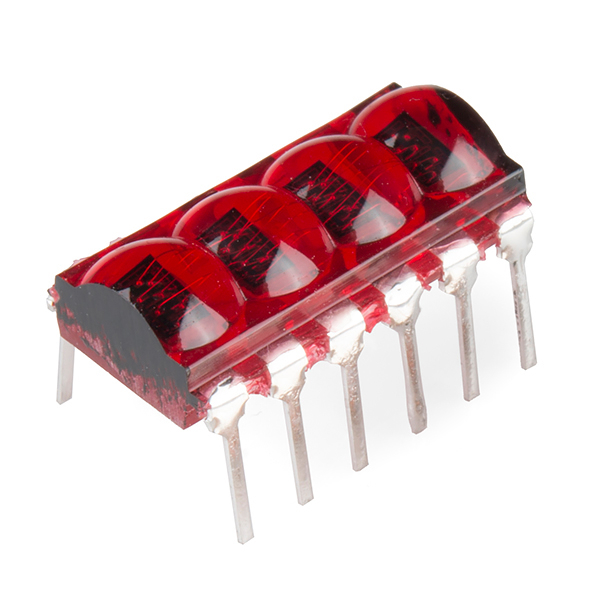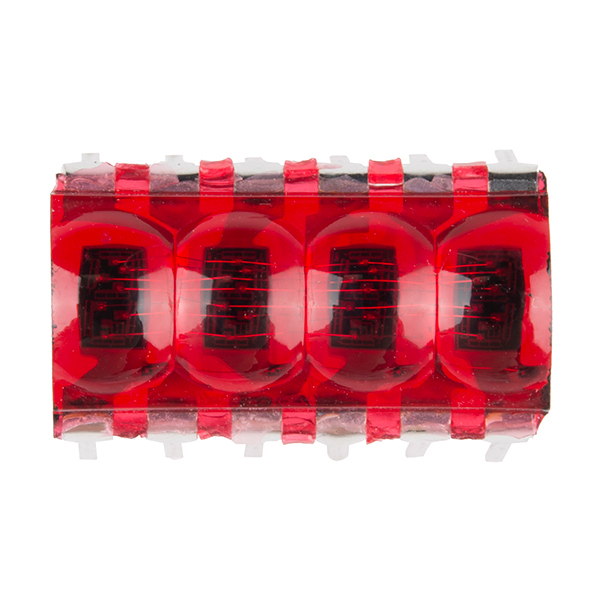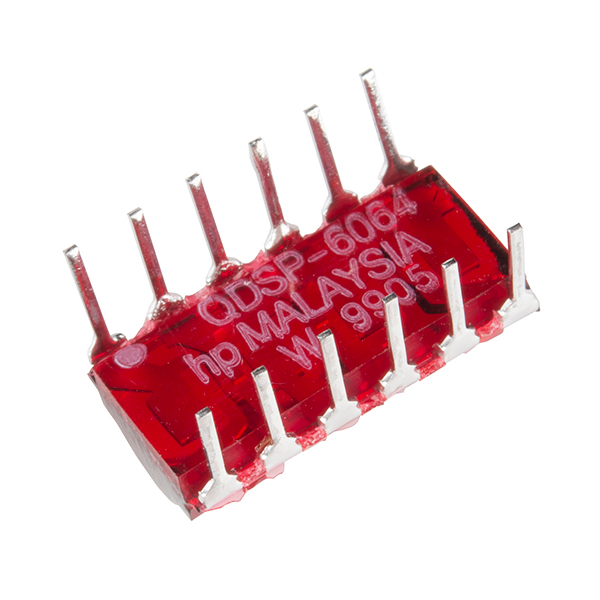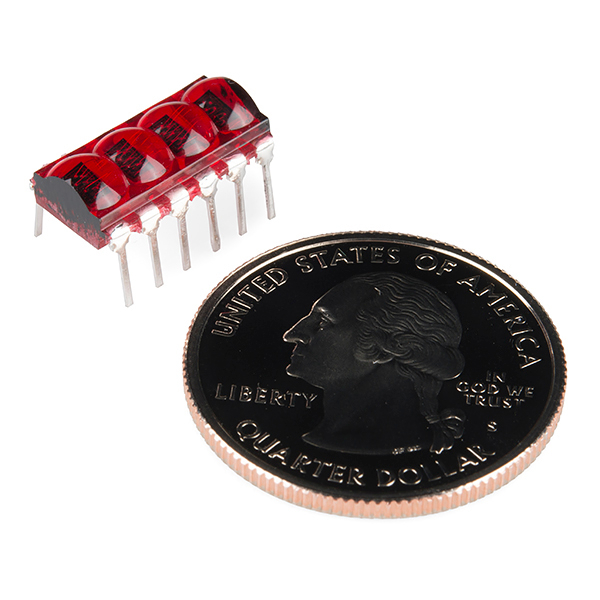Bubble Display - 7-Segment (4-digit)
This is the HP QDSP-6064 bubble display, a tiny, 4-digit, 7-segment numerical indicator. THis little guy is perfect if you need some user feedback from your system, but don’t want to fiddle with LCDs or other display options. The Bubble Display comes in an easy-to-use 12-pin DIP package and can be used in breadboards, protoboards, or PCBs.
These bubble displays have a peak forward current per segment of 5mA at a peak forward voltage of 2V. Thanks to a neat magnification technique used by the QDSP-6064 (giving it the "bubble" name), the luminosity is intensified making lower power consumption possible.
- Forward Voltage: 1.6-2.0V per segment
- Forward Current: 5mA per segment
- Peak Wavelength: 655nm
Bubble Display - 7-Segment (4-digit) Product Help and Resources
Core Skill: Electrical Prototyping
If it requires power, you need to know how much, what all the pins do, and how to hook it up. You may need to reference datasheets, schematics, and know the ins and outs of electronics.
Skill Level: Competent - You will be required to reference a datasheet or schematic to know how to use a component. Your knowledge of a datasheet will only require basic features like power requirements, pinouts, or communications type. Also, you may need a power supply that?s greater than 12V or more than 1A worth of current.
See all skill levels
Comments
Looking for answers to technical questions?
We welcome your comments and suggestions below. However, if you are looking for solutions to technical questions please see our Technical Assistance page.
Customer Reviews
4.5 out of 5
Based on 8 ratings:
1 of 1 found this helpful:
Durable Little Display
When I was hooking the display up, I accidentally lit up a segment with no resistor and it was bright! Luckily it didn't burn out, so I decided to use it directly soldered on the back of an Arduino Pro Mini hooked up with an accelerometer to make a mini pedometer. Remember, it really does use up 12 pins! Overall it's a great little display.
2 of 2 found this helpful:
The coolest things ever.
When these went up for sell for the first time, I purchased one without knowing a project for it--that came later while I was waiting for this to arrive (it became a timer). The total current you will get through each segment is small enough you can use an Arduino to control the common cathodes directly. Use a shift register to control the segments.
3 of 3 found this helpful:
I remember having seen these in calculator from way back. These displays are tiny, easy to use and have very low power consumptions, which makes me wonder why they are considered obsolete and why many stopped building them.
Ive found these to be great to work with. their low current rating allows me to drive them from a microcontroller with ease and their tiny size gives for great adaptibility. Ive mostly been using these as displays for POST(Power-on self-test) messages in my more complex projects to find out if something is malfunctioning.
super retro display
great price, beautifull display. Stop manufacturing this best piece of technology is big lost for humanity. I have used this dusplay in my retro watch https://www.tindie.com/products/bobricius/wrist-watch-with-retro-display-an-lir2032-rechargeable-battery/
Great display
A great way to get information from your project and for less than $3, you can't beat the price.
Best thing ive ever owned!
I use it with the Double Bubble Backpack to make these displays easier to use. They're retired on here but if your lucky you can still find them on google.
Super-tiny seven-segment display
This thing is tiny. It actually surprised me how tiny it was. But it's perfectly readable and isn't particularly hard to wire up. I got one working with a Raspberry Pi, a breadboard, some jumpers and resistors, and a few minutes of coding. If you're looking for a small, easy-to-use seven-segment display, this is what you're looking for.
vintage display
very good quality! very clear, und sooooooooooooooo cuuuuute!






Any chance we might be seeing these come back in stock? I love these little things! Perfect for many of my projects :)
A sad orphan holds an empty Sparkfun delivery box
Please sir... can I have some more... ?
NOOOOO!!! I meant to buy some before they went out of stock... ARGH I knew this would happen. I hate being poor.
No idea what I'll use it for, but don't care: shut up and take my money!
Sounds like your plans for this are about the same as mine.
If you need some inspiration, check out my "bubble" clock: http://timewitharduino.blogspot.ca/2014/04/micro-clock-with-7-segment-bubble.html
Daaaaamn! Those watches are foine!!!
FlorinC.. yours is definitely cooler than mine: https://plus.google.com/116594109930028972427/posts/gisFDTogqaC
How about this? http://steampunker.ru/blog/7052.html
They look nice. I'm taking 10! Plans? Um... Storing them in one of those nice red SFE boxes?
WOW! This is fantastic! I have been looking for these for months. I could find only the odd bit of dusty/corroded NOS (new/old stock) here and there.
Are these currently in production? Or is this a limited supply of NOS? (The date code on the photo is from 1999)
Some applications: 1) position and setting indicators on control panels with rotary encoder control (example: gain of a microphone preamp) 2) Indication of graphic "page" input for a video switcher (example: BlackMagic Design ATEM TV Studio) 3) voltage/current display on a "power brick"
Closest I can find are HDSP-2541 on alltronics, but it's at $70/ea. Mouser seems to have similar ones, but for similar prices. Those Alphanumeric ones are insanely pricey.
They do seem to have the 4-character QDSP-2009, the 4-character DL2416T, and the 6-character SCDQ5580, though. Still many times more money than this product here.
I'd say it's highly likely these are el-cheapo Chinese copies, not the real original HP ones. If you look at the mouldings they don't look as elegant (not uniform) as HP gear was in those days, also the way they are cut-off on the ends looks like it's cut off further up the bubble than the datasheet shows. Maybe I'm wrong, but I'd be very surprised indeed if these turned out to be actually made by HP. I recall a friend's dad having a gold watch with these in it, might have been a HP, can't recall. You had to press a button to get it to light up, so as not to drain the batteries.
In case anyone was wondering, the way you control 32 discrete LEDs (4 x 7 segments plus four decimals) is through strobing. At first I thought this was charlieplexed, but you're effectively just lighting each digit one at a time so fast that people barely register the refresh.
It's called multiplexing. Strobing is something different.
I encourage you to download the spec. It's a pretty interesting part and there's more details there about the strobing approach. There's no demux in this chip.
I still have an HP67 that uses these, still functional. The nostalgia is strong with this one...
A picture of this in action from a bit of distance would be awesome. It's a little hard to tell how visible these would be due to their small size.
+1 for illuminated picture
We're getting a picture of it in action up shortly. Until then the Product Video has a pretty good demo shot. :)
If you need some inspiration, please check out my "bubble" clock: http://timewitharduino.blogspot.ca/2014/04/micro-clock-with-7-segment-bubble.html
Is this ROHS Compliant?
I went to sleep -250 in stock. Wake up- back ordered! These look like a lot of fun for mini projects but SF should spruce them up a notch. Why not take an ATmega and make a tiny backpack (uber small breakout board sorta) to make the display controllable over i2c? A tiny i2c version would be incredibly useful
Here is an I2C controller board. https://forum.sparkfun.com/viewtopic.php?f=14&t=38056
I agree; a tiny I²C breakout for this would be awesome!
Any chance of getting the alpha-numeric version with the extra segments?
This in surface mount would be even more awesome. I want one anyways.
I don't think HP made these in SMD/SMT packages. It seems pretty simple, so maybe Sparkfun could make their own? or find something close. I think this would stand out on any project and would generate a lot of sales if offered in an array of colors too.
I have an old HP calculator front that needs some of these put in it (along with some kind of microcontroller to make everything work, of course).
Edit: Cad file is the 5082-7414 here: http://www.cadsoftusa.com/downloads/file/hp-displays.lbr posted by Member #143107
Hi, please, could you suggest a really tiny 7 segment driver chip, perhaps in smd format? i would likt to access it in a i2c chain or in serial connection. 74HC595 seem to be apropiate but it's really big in fisical size. attiny85 doesn't arrive and someone used attiny2313 in smd format, but is appropiate to use a microcontroller for that? so any idea?
Aw, man!
These are exactly what I was looking for on a project about a year ago. Went with 7-seg VFD's instead, though, which was pretty cool itself.
I want to know the price and delivery time for 1000pcs?
Please contact customerservice@sparkfun. They can assist you with quotes and time frames for large scale orders like that.
I was asked to customerservice@sparkfun.com, the answer is no. Please check
If customer service said we were unable to do that, then unfortunately, that's the case. They have all the information regarding quantity limits per customer and delivery times. Sorry about that! Best of luck.
One kind of let you more questions.
Where I can buy up to 100pcs?
And, there have more than thousands of stock?
We have the pricing breakdown listed above for 100+ pieces. Unless CS told you something differently, you should be able to buy some here. Regarding getting thousands or more, unfortunately, I think that would just require searching around to find a supplier with a large enough stock on these.
I want to know the prices and delivery time for 1000pcs?
I would make a clock...
I have created a Fritzing part for this display. It's not fancy, but it has a proper schematic and pin labeling.
These are very cool - I'm using them with an FPGA project (pretty simple to run from there), but they would be simple with a microcontroller too. I'm strobing each digit on a 25% duty cycle 50 times a second or so, using a transister (2N2222) to switch the cathodes (which is a good idea unless you know your IC's output pin can sink 40ma on a 25% duty cycle. I don't know why Sparkfun suggests putting resisters on the cathodes in their hookup guide - resisters are cheap, so put them on the anodes and don't worry about your "8" looking dimmer than your "1". So...Buy one. You want one.
I'd like to use this for an in-helmet heads up display. I can't decide if that lens would make these better or worse for that purpose. Can someone in possession of one of these tell me how close you can hold it to your face and still read it well? Assume approximately the Google Glass location.
I can read it clearly at the same distances I can read text printed on paper. I wouldn't think, at least not without some optics, that this would be good to mount on glasses.
Thanks for the followup. Now that I have one I have been able to confirm the same results as you. For me, the nearest I can focus on this is 300mm from my eye. I need to mount it 85mm away or less. The highest magnification lens I have to play with is 4x and that doesn't even seem to be half of what I need.
ok. a question about something i noticed
Are they truly 5mA...or are they 500uA(0.5ma) as specified by the datasheet? oh nvm...damn wonky knockoff datasheet at times...
These are great little displays and a lot of fun to work with. I bought an Adafruit HT16K33 breakout board for $6 and managaed to get three of these displays working with the single board so far. I think four would be no problem but the wiring gets a little hairy. Still, it is incredible that four 4-digit, seven-segment displays can be controlled through a Pro Mini with just power and TWI! It leaves all the other IO pins free for sensor interfaces and the like. It should be pretty straightforward to design a breakout board that incorporates the HT16K33 chip and four bubble displays, individually addressable, as an integrated unit (like the standard LED backback) in a very compact sze. The coding to access and address the separate displays is trivial; the HT16K33 makes these bubble displays very easy to use. What a great combination!
Cool product! Can they be used with a coin cell batery?
I don't see why not, voltage and current-wise it's well within a coin cell's capabilities even when adding control circuitry. There's a watch that use a display like this and an LIR2032 (rechargeable li-ion type battery), though I suspect it should work with a regular CR2032 (non-rechargeable) as well (perhaps with minor tweaks).
Their right out of Star Trek!
I used some original HP 4 digit displays that work nicely as a 4 diigt clock. I bought the displays about a year ago from ebay and finally made a clock using a PIC16F84 and a lot of mistakes, I mean "software development"
http://tmcalind.mnsi.net/HOBBYIST/4LED_timcard_clock_framed2.JPG
I wonder if the W 9905 is a date code, i.e. 5th week of 1999. Glad I got mine while there was stock :)
I still have some calculators that use these. They also remind me of this passage from Isaac Asimov's book, Foundation, written in the early 1950's, long before these were available:
By the way, some of the 4-digit displays of similar digit height that are current and available (made by Avago (spin-off from HP), Osram, and others) are, as others mention, much more expensive. But they are also full alphanumeric, with a 5x7 dot character, and have intelligence built in for driving them. So some aren't that much more expensive than these bubble displays would be with a backpack controller board.
Am I the only one who looked at these and immediately thought "Mattel Electronic Football"?
Out of stock already!?!?
I know, right? Product video went up on Friday, and at that point there were about a thousand in stock. I checked back on Saturday and it was down to 500ish. At that rate, they'd be OOS in a few days, tops. I'm glad I ordered when I did. These things just look way too cool to pass up.
I wonder who's supplying Sparkfun with this part. HP?
I'm pretty new to this but this would be about the right size to add a counter to the Simon Says game so you can challenge your friends to see who can get the farthest. I have a really hard time trying to memorize the steps to repeat and count how far I've gone. Though without a simpler interface like a i2c board probably would be too many wires hanging out. Anyone ever put a counter to the simon game?
go to the ham flea markets, you will find these things in equipment selling for a dime a dozen or you can go to Goodwill and buy old calculators for a dollar a pound....
Yeah but then you gotta take the rest of the equipment home, too. :)
Does someone has a photo how it looks like when two are directly next to each other? does it look nice, and as one whole part?
I was looking for a unique alternative to the 16x2 LCD for CPM on the DIY Geiger counter project I have rolling. This will definitely get me down to the size goal I have. I don't say this often but: way to go SparkFun.
might find these of interest - http://tronixstuff.com/2012/04/07/hewlett-packard-5082-7415-led-display-from-1976/ http://tronixstuff.com/2013/05/12/tutorial-arduino-and-mc14489-led-display-driver/
This display has the same dimensions and pinout as the 5082-7404 from HP. I have made an eagle library for this display and a 3, 5 and 9 digits versions. See http://www.cadsoftusa.com/downloads/file/hp-displays.lbr
The datasheet notes that the letter designating the intensity is on the "hack side of the package". Leading to the obvious question: What are the other sides?
The hop and the 2 hides of course.
I have a warm fuzzy at seeing one of the first displays I learned about in the SFE catalog, I can't wait to use them.
Tiny size, Self magnifying, very low power draw, Awesome "retro" appearance. DIP12 format. Everything screams "AWESOME" about this product.
With specs like these i wonder why these bubble displays stopped being made (not sure about this version, if still in production that is EPIC, cant find much info about these around). Especially with miniaturization and "Low-Power" being rather important now they would make pretty handy displays in tight spaces.
I like many am confused about the offering of these. are they surplus (NOS)? Normally i would judge by the Datasheet, but surprisingly the datasheet looks rather young.
Oh last bit i did notice that is of possible interest. These guys were designed with the possibility of installing them tilted. the leads can bend so that the display tilts up to 20 degrees.
LOL, I have stolen these out of old electronics I have gotten at thrift stores in the past.
Looks like LED displays have come full circle as this is very similar to one of the first 7 segment multiple digit displays that became available back around 1970 except I believe it was only 3 digits (and I believe was also from HP).
I've still got a bunch of these that I picked up in the '80s and they're really great. I actually used them in a couple of projects when I was doing some contracting and my customers loved the retro look. The multiplex code is pretty simple and any microprocessor that can spare 11 I/O pins can drive these.
Definitely worth a look, especially with today's tiny processors.